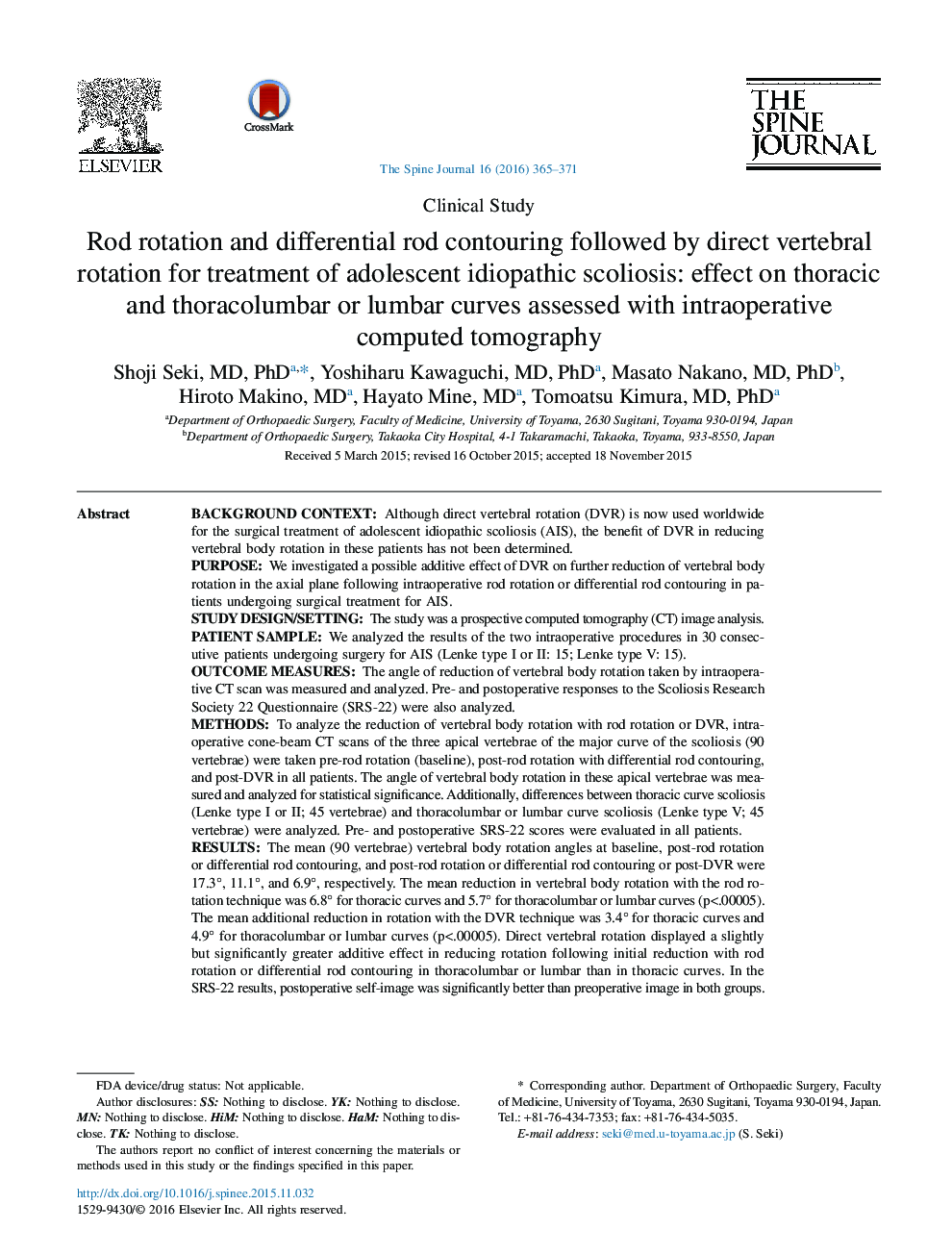| Article ID | Journal | Published Year | Pages | File Type |
|---|---|---|---|---|
| 4096295 | The Spine Journal | 2016 | 7 Pages |
Background ContextAlthough direct vertebral rotation (DVR) is now used worldwide for the surgical treatment of adolescent idiopathic scoliosis (AIS), the benefit of DVR in reducing vertebral body rotation in these patients has not been determined.PurposeWe investigated a possible additive effect of DVR on further reduction of vertebral body rotation in the axial plane following intraoperative rod rotation or differential rod contouring in patients undergoing surgical treatment for AIS.Study Design/SettingThe study was a prospective computed tomography (CT) image analysis.Patient SampleWe analyzed the results of the two intraoperative procedures in 30 consecutive patients undergoing surgery for AIS (Lenke type I or II: 15; Lenke type V: 15).Outcome MeasuresThe angle of reduction of vertebral body rotation taken by intraoperative CT scan was measured and analyzed. Pre- and postoperative responses to the Scoliosis Research Society 22 Questionnaire (SRS-22) were also analyzed.MethodsTo analyze the reduction of vertebral body rotation with rod rotation or DVR, intraoperative cone-beam CT scans of the three apical vertebrae of the major curve of the scoliosis (90 vertebrae) were taken pre-rod rotation (baseline), post-rod rotation with differential rod contouring, and post-DVR in all patients. The angle of vertebral body rotation in these apical vertebrae was measured and analyzed for statistical significance. Additionally, differences between thoracic curve scoliosis (Lenke type I or II; 45 vertebrae) and thoracolumbar or lumbar curve scoliosis (Lenke type V; 45 vertebrae) were analyzed. Pre- and postoperative SRS-22 scores were evaluated in all patients.ResultsThe mean (90 vertebrae) vertebral body rotation angles at baseline, post-rod rotation or differential rod contouring, and post-rod rotation or differential rod contouring or post-DVR were 17.3°, 11.1°, and 6.9°, respectively. The mean reduction in vertebral body rotation with the rod rotation technique was 6.8° for thoracic curves and 5.7° for thoracolumbar or lumbar curves (p<.00005). The mean additional reduction in rotation with the DVR technique was 3.4° for thoracic curves and 4.9° for thoracolumbar or lumbar curves (p<.00005). Direct vertebral rotation displayed a slightly but significantly greater additive effect in reducing rotation following initial reduction with rod rotation or differential rod contouring in thoracolumbar or lumbar than in thoracic curves. In the SRS-22 results, postoperative self-image was significantly better than preoperative image in both groups.ConclusionsDirect vertebral rotation contributed an additional reduction in vertebral body rotation in thoracic and thoracolumbar or lumbar curves. The DVR technique is likely to be more useful in thoracolumbar or lumbar curve scoliosis than in thoracic curve scoliosis.
